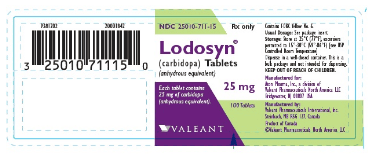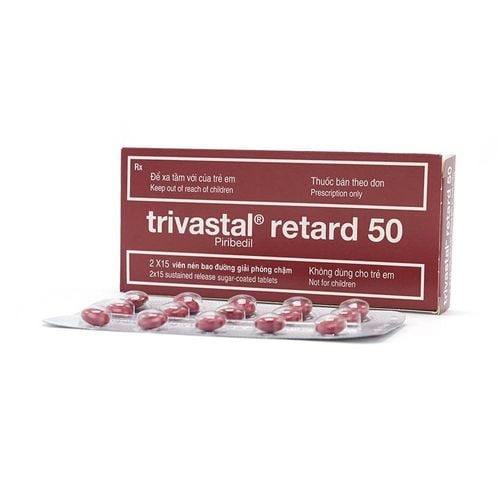This is an automatically translated article.
Apomorphine is a drug used in the treatment of Parkinson's disease. During treatment, patients need to adhere to the dose of Apomorphine prescribed by the doctor.
1. What is Apomorphine?
Apomorphine has the main ingredient Apomorphine, which is a Dopaminergic agonist, used to treat Parkinson's disease. Apomorphine is prepared in the following forms and strengths:Solution for subcutaneous injection with the concentration of 10 mg/ml. Film placed under the tongue with the strength: 10mg, 15mg, 20mg, 25mg, 30mg. Apomorphine acts like Dopamine, it is a direct stimulant of Dopamine receptors. Although Apomorphine has both D1 and D2 receptor agonist properties, it does not share a transport or metabolic pathway with Levodopa.
Apomorphine is indicated in the acute supportive treatment when patients have "wearing off" or "off" phases of Parkinson's disease - when the effect is lost near the end of the dose or the response is slow or unresponsive. With Levodopa, the patient developed motor symptoms even while taking levodopa in the advanced stages of Parkinson's disease.
Apomorphine is contraindicated in the following cases:
Concomitant use of Apomorphine with serotonin 5-hydroxytryptamine-3 (5-HT3) receptor antagonists including antiemetics; Hypersensitivity to any of the ingredients of the drug; Patients with depression; Patients with central nervous system depression; People with neuropsychiatric problems; Patient has dementia.
2. Dosage and usage of Apomorphine
Dosage of Apomorphine should be according to the prescription of a specialist. The reference dose is as follows:
The initial adult test dose is 0.2ml (2mg). If a 0.2ml (2mg) dose of Apomorphine is effective and tolerated, this dose can be used as needed, on an outpatient basis. If needed, your doctor may increase your dose by 0.1ml (1mg) every few days. The dose should not normally be increased to 0.4ml (4mg) as an outpatient in these patients. The initial dose of Apomorphine should be 0.2ml (2mg). If you have severe orthostatic hypotension, do not continue to use this medicine.
For patients tolerating Apomorphine, but not responding to a dose of 0.2ml (2mg), administer a second test dose of 0.4ml (4mg) on the next observed "off" (at least at least 2 hours after the initial test dose). If tolerated, the initial dose of Apomorphine should be 0.3 ml (3 mg). If necessary, the dose of Apomorphine can be increased by 0.1ml (1mg) every few days.
For patients who respond to Apomorphine, but do not tolerate the 0.4ml (4mg) test dose, continue with the third test dose of 0.3ml (3mg) at the next "off" time. observed (at least 2 hours after the last test). If a 0.3ml (3mg) dose of Apomorphine is effective and tolerated, a 0.2ml (2mg) dose can be used as an outpatient, as needed. The dose of Apomorphine should not normally be increased to 0.4 ml (4 mg) as an outpatient in these patients.
Most patients respond to apomorphine doses of 0.3–0.6ml (3–6mg); The average frequency of taking Apomorphine was 3 times per day. If Apomorphine therapy is interrupted for more than 1 week, you should restart it with 0.2ml (2mg) and adjust the dose gradually to take effect.
For sublingual film, the starting dose is 10mg; no more than 5 doses/day. Doses at least 2 hours apart; If a single dose of Apomorphine is not effective for a particular "off" then you should not use a second dose for that "off". The maximum dose is 30 mg/time.
In patients with mild or moderate renal impairment, the initial trial dose of Apomorphine and subsequent starting dose is 0.1 mg (1 mg).
How to use Apomorphine as follows:
Injectable form, injected under the skin in the abdomen, thighs, or upper arms; alternate injection sites. Determine the dose of Apomorphine (test dose) when the patient is going through an "off". It is possible to actively induce an "off" state by stopping the patient's Parkinson's medications overnight. Determination of the test dose should be done in a medical facility where blood pressure can be closely monitored. Measure the patient's supine and standing blood pressure before and after 20, 40, and 60 minutes at each test dose. Symptoms of apomorphine overdose include excessive vomiting, respiratory depression, hypotension, and bradycardia. Treatment of overdose is mainly symptomatic and supportive treatment. Excessive vomiting can be treated with Domperidone. Respiratory depression can be treated with naloxone.
3. Apomorphine side effects
Common side effects of Apomorphine include:
Hallucinations; Neuropsychiatric disorders including transient mild confusion and visual hallucinations; Sleepy; Dizzy; Nausea and vomiting; Injection site reactions such as subcutaneous nodules, stiffness, erythema, pain, and inflammation of the skin tissue. Less common side effects of Apomorphine include:
Hemolytic anemia; Thrombocytopenia; Rest movement disorders; Orthostatic hypotension; Shortness of breath; Rash; Necrosis and ulceration at the injection site. Rare side effects of Apomorphine include:
Eosinophilia; Allergic reactions include anaphylaxis and bronchospasm. Side effects of undetermined frequency of Apomorphine include:
Impulse control disorders such as excessive gambling, lust, increased libido, binge eating, excessive spending or shopping; Peripheral edema; The Coombs test was positive.
4. Apomorphine drug interactions with other drugs
Concomitant use of Apomorphine with drugs that prolong the QT interval (eg, Azithromycin, clarithromycin, erythromycin, quinolone antibiotics, fluconazole, itraconazole, metronidazole, ketoconazole, amphotericin B, trimethoprim - sulfamethoxazole) increases the risk. prolongation of the QT interval. Concomitant use of Apomorphine with antihypertensives and vasodilators leads to an increased risk of orthostatic hypotension, pneumonia, MI, an increased risk of serious falls, and bone and joint injuries. Concomitant use of Apomorphine with CNS depressants increases the sedative effect. Concomitant use of Apomorphine with 5-HT3 receptor antagonists (eg, Dolasetron, Granisetron, Ondansetron, Palonosetron) will cause excessive hypotension and loss of consciousness. Concomitant use of Apomorphine with Dopamine receptor antagonists (eg, Phenothiazines, Butyrophenones, Thioxanthenes, Metoclopramide) will decrease the effectiveness of Apomorphine. Drinking alcohol while using Apomorphine will increase the sedative effect and lower blood pressure. In summary, the drug Apomorphine is used in the treatment of Parkinson's disease. In order to use the drug safely and to maximize the effectiveness of treatment, the patient needs to take the drug as prescribed by the doctor.
Please dial HOTLINE for more information or register for an appointment HERE. Download MyVinmec app to make appointments faster and to manage your bookings easily.













